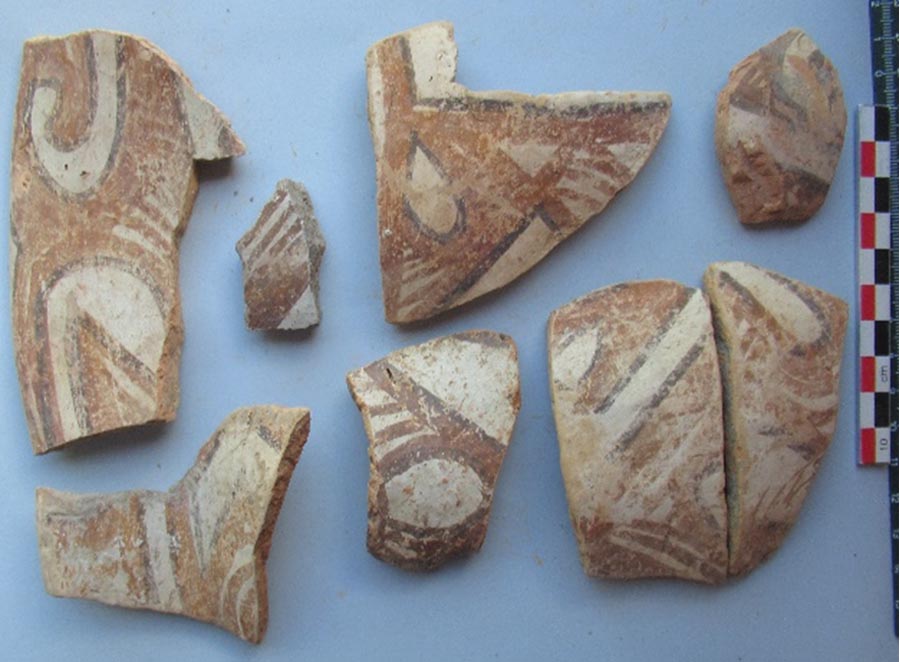China's overseas archaeological projects bearing fruit
According to statistics of the National Cultural Heritage Administration, Chinese archaeologists participated in 38 archaeological projects overseas in 2019, cooperating with around 20 countries.
In the early 1920s, modern archaeological practices only began to emerge in China after Swedish geologist Johan Gunnar Andersson introduced western methodologies and led key excavations across central and west China.
Colorful pottery pieces of Cucuteni culture unearthed in Dobrovat, Romania, in 2019. [Photo provided to China Daily]
Yangshao Culture, which dates back to between 5000 and 3000 BC and is best known for its colorful pottery vessels, is undoubtedly one of his most important discoveries, one that unveiled China's rich Neolithic heritage.
But because similar patterns were discovered emblazoned on the contemporary ceramics of Cucuteni culture in what today is Romania, Andersson made an arbitrary deduction: Chinese civilization was not original. Instead, he believed, it was introduced from the West via the Eurasian grasslands. This theory influenced academia for decades.
Although Andersson's speculation was later disproved by subsequent archaeological findings in China that reflected the spontaneous roots of Chinese pottery culture, Cucuteni remained a mesmerizing name for generations of Chinese archaeologists: Where did the similarities arise?
In July, four archaeologists from the Institute of Archaeology at the Chinese Academy of Social Sciences set off on a two-month trip to explore Cucuteni Culture in Romania, on what was the first phase of excavations in the village of Dobrovat, near the city of Iasi in that country's northeast.
"Andersson's archaeological findings and mindset have their limitations," Wen Chenghao, an archaeologist working on the project, tells China Daily. "However, he left a lasting legacy for us. It was necessary for us to gain a comprehensive overview of our own for comparison."
A pair of gilded silver dragons found in a 2,000-year-old Xiongnu graveyard in Mongolia. [Photo provided to China Daily]
Test of hypothesis
A 6-hectare heritage site in Dobrovat, dating back to around 4300 BC in the early stages of Cucuteni culture, was the focus of their research. The remains of nine houses had been discovered and the earth, which was used to construct them, was found to be scorched.
Charred earth was also found at sites dating back to the Yangshao period in China, and were widely assumed to be a type of consolidated building material.
According to Wen, however, in Dobrovat, the condition of the 20-centimeter-thick blocks of earth — some of them vitrified at a temperature of over 1,000 C — instead suggested that these dwellings had been deliberately burned to the ground.
"It's likely that these intense fires were not accidentally caused by war or looting," he says. "This may reveal that certain religious rituals took place when people abandoned their homes. This inspired our future studies into similar phenomenon in China."
Since no Cucuteni culture graveyards have yet been discovered, Wen further speculated that Cucuteni burial customs may have dictated that people were burned together with their houses after they had died.
"After being inhabited for years, the houses were no longer treated as wood and earth," Wen says. "Instead, they were thought to be 'alive' — and something spiritual."
He says he has learned a lot from his Romanian colleagues.
"When we conducted careful and detailed analysis of these earth structures, just like examining and rebuilding the broken pottery discovered there, they helped us reconstruct the original appearance of these dwellings and reveal an abundance of easily overlooked historical information."
Chinese archaeologists will also help to solve problems at the site.
Since two-thirds of the Dobrovat site is covered by thick forest, most electronic detectors don't work there. Wen says they will take a "Luoyang spade" — a traditional tube-shaped testing tool widely used by Chinese archaeologists to examine the layers of soil to locate possible underground relics — to Dobrovat for the second phase of excavations later this year.
Although two months seemed too short a time to completely answer the questions raised by Andersson a century ago, Wen says the hypothesis of communication between the Cucuteni and Yangshao cultures, separated by 7,000 kilometers, seems improbable.
"It was our romantic imagination before we did field research in Dobrovat," he says. "However, despite the similar patterns on the colorful pottery, other unearthed objects from the two cultures appear markedly different.
"Nevertheless, their apparent 'similarities' — even the patterns of colorful potteries — seem to reflect that people in different regions shared paths in social development carried over from Neolithic times to the Bronze Age. Comparative cross-cultural studies require an insight into historical precedents rather than by simply examining scattered signals."



